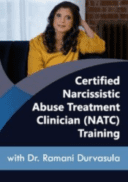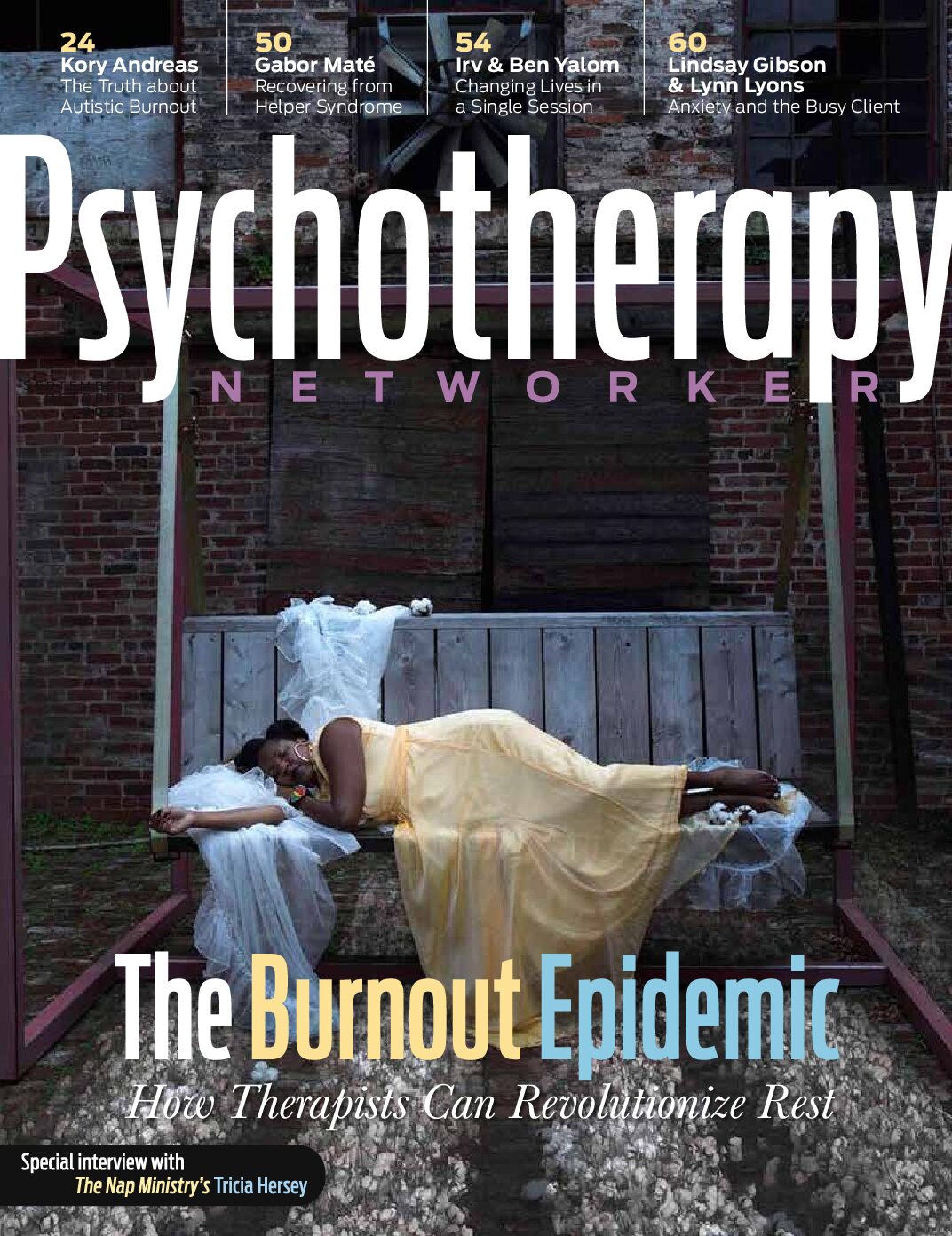Lately, I’ve been noticing an emerging trend—one that may be flying under your radar but reflects conversations I’m having each week with therapists. More and more colleagues are expressing a desire to move beyond the constraints of insurance and geographic limitations, or to shift away from a constant focus on trauma and suffering. They’re not looking to abandon their current caseloads or stop being therapists, but rather, they want to add something new—something different.
They’re desperate for a change, much like my client Ari, a therapist who’s been operating a solo private practice for the past decade and is beginning to feel a pervasive sense of fatigue. During a rare summer break at the beach, she read a book on resilience that encouraged her to assess all areas of her life to identify what was draining her energy. This led her to reconsider her caseload, full of complex trauma cases. Of course, she could adjust her schedule of 25 sessions a week, but was that really the source of her exhaustion? She dug deeper and realized that while the number of clients she was seeing might play a role, it was the constant focus on abuse-related trauma that was wearing her out.
“I’m burning out, Lynn,” she told me during our first business coaching consultation. “I have a full caseload and a wait- list of adults who were abused in early childhood—I do trauma work. The work can get complicated and dense at times, for my clients and for me as their therapist. I’m not going to stop being a trauma therapist: I feel called to do it. But I want to add a different type of service to my practice . . . a really different type.”
“What would that look like?” I asked.
“I’m the parent of an Autistic child. He’s finally launched, in his first year of college, but getting him there taught me a lot about parenting neurodivergent kids and how to navigate the resources available. I think I can give other parents ideas, hope, and guidance—but not as a therapist, more like a partner who supports their journey.”
“You want to be their coach,” I said.
“Yeah,” Ari responded, smiling wryly, “but every time I mention the idea to my colleagues, they either shake their heads in disdain—like, ‘Oh no, not you too’—or they cringe—like, ‘Why would anyone want to be a coach when you have a license to practice therapy?’ I hope you can help me figure this out. What’s the difference between a coach and therapist these days anyway?”
Two Professions Colliding
I identify primarily as a therapist, but I’ve also worked as a coach in various capacities for over 30 years. Given my diverse background, transitioning into coaching as a therapist wasn’t difficult. After all, therapy was my second or third career, following an undergraduate degree in art, managing the family scrap metal business, running a small side business, and eventually returning to school for an MSW. I quickly built a private practice; and while my work as a therapist was deeply fulfilling, I missed the strategic mindset I’d used in business.
Despite having a full therapy caseload and being a single parent, I made time to complete a two-year coach training program. At first, I wasn’t sure how I’d apply what I’d learned, but as managed care began to stir anxiety among therapists, I began teaching small groups of therapists in my office how to navigate the business side of their practice. Over time, I began writing, presenting, and consulting to translate business concepts for therapists—all within a coaching framework. Eventually, I joined the faculty of a large coach training school, and I wrote books and articles about coaching to help therapists—my home team—better understand the newcomers on the field.
When asked about being both a therapist and a coach, I’d explain that my work as a therapist informed my coaching. But as coaching developed into an established field with its own body of knowledge, I found the reverse to be true as well: coaching informed my work as a therapist. Integrating both professions enriched the entire spectrum of my work.
Therapy and coaching have always been kissing cousins. From its inception, coaching looked at many professions for content and wasn’t shy about borrowing from the arena of personal growth. No wonder therapists initially dismissed coaching as a fad or therapy-lite, a lesser version of therapy. But in the last decade, coaching has begun to push the boundaries of mental health services even further. Established therapeutic methods are transforming themselves into coaching methods. A quick internet search shows providers offering “narrative coaching,” “acceptance and commitment coaching,” and “ADHD coaching.” Some find the blurring of solidly therapeutic mental health treatment methods into coaching programs disconcerting, and I agree that trying to make sense of these blurred lines is an example of the challenges within the unregulated coaching profession.
Most coaching training is offered via for-profit, individually owned, non-university-based centers. Without regulation, many public offerings from coaches can be misleading in tone and content. Perhaps most concerning, anyone can call themselves a coach without requiring formal training or certification. This is why Ari’s colleagues had scoffed in disdain. Coaches can be an unregulated, overpromising, and underperforming bunch. While this creates a “buyer beware” market for those seeking coaching services or training, coaching remains in high demand. Why, despite the lack of regulations, is coaching so popular?
One reason is that coaching fills an unmet need. It bridges the gap between therapy and proactive self-improvement. Many people want help, but don’t consider themselves in need of psychological “treatment.” Instead, they’d say that they want to improve life skills, gain confidence, or set and meet specific personal and professional goals. But they’d like to do this with guidance and help, one-on-one. The upside for therapists is that now, because this gap is defined and coaching is widely accepted as another avenue for personal growth, it provides therapists with an opportunity to expand their services.
Taking this one step further, I believe therapists often make the best coaches. A coach with a master’s degree or higher in mental health can be incredibly reassuring to clients. Not only does this background add credibility, but it brings a deeper understanding of human behavior—something that can significantly enhance the effectiveness of coaching. Evidence bolsters the need and place for coaching. Current research suggests coaching can be an effective, available, low-intensity intervention, offering an alternative to traditional clinical treatments for depression and anxiety.
Defining the Differences
When Ari asked for my help to clarify the difference between therapy and coaching, I was reminded of a plenary discussion I attended back in 1996, sponsored by the only coaching certification organization at the time. I listened with growing concern as a panel of coaches tried to differentiate coaching from therapy. One panelist said, “Coaching focuses on the present and future, while psychotherapy focuses on the past.” Another added, “Coaching is about achieving goals, while therapy is about developing insight.” Others chimed in, “Coaching is short-term, while therapy can take years,” and “A coach listens and talks back to you like a real person, while a therapist is a silent, blank screen.” As the only therapist in the room, I explained that these definitions were overly simplistic at best and inaccurate at worst. We therapists know that psychotherapy, a profession that has existed for over a century and includes hundreds of methods, can’t be neatly summed up in one sentence.
Still, there are distinctions—and an important one lies in the populations served. Therapy is designed for those dealing with varying levels of vulnerability and need; while coaching is appropriate only for those who are functional enough to take action steps, even if those steps are small at first. Another is the setting: Therapy sessions must be confidential and contained to support treatment objectives and methods. Coaching sessions should also be confidential; however, coaches often work in informal, less restricted settings—such as meeting with a busy executive in a local coffee shop.
Although there are differences in the purpose of therapy and coaching, there’s also overlap. The extreme examples of each—say, psychoanalysis versus sports coaching—makes it easier to see. But modern cognitive therapy and life coaching often aim to achieve similar objectives, such as helping clients feel self-actualized and productive, or building confidence, self-awareness, and better relationships.
When the goals of therapy are comprehensive—to help a person gain insight, heal emotional wounds, eliminate self-destructive behaviors, or bring about characterological development—therapy again becomes distinct from coaching. Therapists take a long view of progress and therapy is typically process-oriented—a dynamic, ongoing treatment that delves into both conscious and unconscious drives. A therapist might consider the therapy successful if, after treatment, a client has made subtle internal shifts in thinking, feeling, and behaving, even if the client is functioning in the world in a low to moderate range. Part of the purpose of therapy is wrapped up in its developing, emergent process.
In contrast, coaching is typically more structured and focused on cognitive development, with a clear, time-bound framework designed to help clients achieve specific goals. The hallmark of coaching is action, which serves as the primary measure of its effectiveness. Key questions to assess progress include: What specific changes have occurred as a result of coaching? What actions are planned next? Can the coach and client quantify progress in observable terms?
The major coaching schools, to their credit, have also been working hard to define what coaching is by identifying a set of eight, detailed core competencies, known as the “coach approach.” Those who are certified and trained in accredited schools are expected to adopt this approach, sometimes also referred to as “pure coaching.” The core competencies have evolved over time, but in my opinion, four factors remain central to coaching. The first involves the locus of control. In the coach approach, it’s understood that the client holds the answers and is the source of their own transformation. Coaches are there to facilitate change, but the client is the one who owns and directs the results.
Pure Coaching
This distinction between therapy and coaching is why coaching presumes the client will be “coachable”—functional, with minimal mental health issues, emotional challenges, or psychosocial complexities, trauma-free with readily available problem-solving skills to find their own answers. Along with this client-based locus of change, there are three more keys in the pure coaching model:
Partnership. Coaches, particularly life coaches, engage with clients from an informal, nonhierarchical position. They aim to be collaborative and authentic, “leveling the playing field” to motivate and encourage clients. They’re less distant or removed than a therapist might be. This positioning helps support the next element: action. (In contrast, therapists take on many roles. At times, we need to be blank screens or avoid self-disclosure to keep the client central to the treatment. Occasionally, we must take a more hierarchical stance, making difficult decisions like recommending hospitalization or providing expert guidance to move forward with a treatment plan.)
Action. Achievement is the hallmark of coaching. Trained coaches use a toolkit of skills to help clients do more and go further, assuming the client is already functional. (In therapy treatment, action is not always a prescribed or welcome outcome. For example, it must be balanced with awareness, insight, emotional regulation, or developing new and better cognition prior to taking next steps.)
Possibility. Coaches are an optimistic bunch. They don’t pathologize problems. They work in the realm of what’s possible and focus on vision, purpose, mission, success, and effectiveness—future-oriented, affirming concepts that drive action and motivation. (Distinct from this, therapists learn to hold an honest, unsparing and at times diagnostic view of a person or situation, to help heal trauma, suffering, grief, and loss in ways that coaching is not designed to tackle.)
In a pure coaching approach, all four of these elements must be present in each and every coaching session. While therapy sessions may include some of these aspects at various times, most therapy models don’t require this exact formula to be present in every session. Coaching, at is most pure expression, is a different method.
The Business of Coaching
How does a therapist pivot to be a coach? I have a business mantra I learned early in my coach training: integrity first, needs second, wants third.
Now that Ari was ready to focus on the logistics of setting up a coaching program in an ethical and professional way, the integrity question meant protecting her therapy license by reviewing her state licensure and code of ethics to determine whether offering coaching as a separate service would affect her professional standing. When she found nothing that would prohibit it, I encouraged her to purchase additional liability insurance specifically for coaching if it wasn’t already covered by her existing malpractice insurance. Ari was exploring membership with the International Coaching Federation, the leading global coaching certification and accrediting organization, which would provide her with a clear coaching code of ethics to follow. To further protect her licensure, we also discussed:
No dual relationships. Given that therapist and coach are separate roles for a therapist, Ari would decide whether to take on the role of therapist or coach for a particular client and stick with that choice. She would not see a client for therapy and then later agree to be the client’s coach.
Maintaining existing therapy policies. In her therapeutic role, Ari already had a social media policy, billing policy, informed-consent packet, and signed contracts for new clients. I recommended she maintain these same policies with her new coaching clients in order to protect her therapy license. Why? Many licensing boards consider a therapist’s primary role to be that of a therapist, and any complaints lodged could result in the therapist being held to the ethical standards of their licensure—even if they’re acting as a consultant, teacher, presenter, or coach.
Identifying a coaching platform. Ari was no longer limited by geographic boundaries when it came to seeing coaching clients, giving her a national platform to reach out to parents across state lines, so when she thought about what to charge, I recommended she look at several criteria: her potential population, the results her services could convey, the market of coaches working in a similar way, and, with my help, a business plan. We decided that her fees for coaching would not match the insurance or fee-for-service model she currently used for therapy services. Instead, she decided to price coaching fees in packages of 10 sessions to encourage parents to see her coaching as a valuable set of strategies and tools, similar to a highly customized course that one would take. Once she finalized her new coaching fees, she set up a system for her coaching notes and administrative record-keeping that would be distinct from the practice-management system she used for therapy sessions (which handled insurance billing, note-taking, and diagnostic coding.) Keeping her coaching administration separate provided an added layer of protection, ensuring that her coaching services wouldn’t be questioned as another form of therapy.
Transparency. Ari worked to clearly define her coaching services, pricing, packaging, and programs on a separate coaching website, as her focus on parenting was distinct from her therapy practice. Since a website is a relatively low-cost way to advertise and gain online visibility, she believed that having two separate websites—each with its own focus—would reduce confusion for potential therapy or coaching clients. On the coaching website, she included a detailed explanation of what coaching entailed and, in the FAQs section, used clear language to differentiate coaching from therapy.
Then, she considered her business needs: finding coaching clients, which required a basic marketing plan that I helped her put together. Finally, she got clear on her business wants: hosting a podcast with her son, so that he could talk about his lived experience as an Autistic person. Despite her excitement about the idea, after evaluating the time and effort she’d need to expend to start her coaching practice, she decided to hold off on the podcast until everything else was in place.
My continued coaching support helped Ari cope with her early unrealistic expectations that her business would take off immediately and find the tenacity to stick with her plan. At each session, I encouraged her to appreciate what she’d already achieved, rather than just lamenting what was left on her to-do list. Our motto was: small steps count. After six months, Ari was ready to space out our sessions with some breaks, and I readily accommodated her.
Coaching Ari meant trusting her judgment to set the pace of our work, while I offered partnership, structured action steps, and a steady focus on possibilities—ensuring she could experience the kind of coaching she might one day offer others. My coaching style incorporates a strong element of business consultation, so Ari also received practical guidance as needed. Over time, she naturally embraced a new coaching role, skillfully balancing the unique demands and approaches of both professions.
Lynn Grodzki
Lynn Grodzki, LCSW, MCC, is a psychotherapist in private practice, a master certified coach, and the author of Therapy with a Coaching Edge: Partnership, Action and Possibility in Every Session and Building Your Ideal Private Practice.













